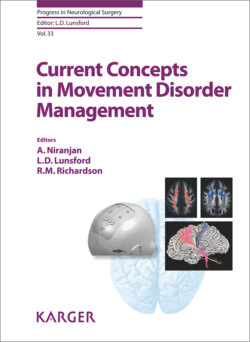Читать книгу Current Concepts in Movement Disorder Management - Группа авторов - Страница 38
Essential Tremor
ОглавлениеET consists of oscillatory involuntary movements, usually occurring when affected individuals engage in voluntary movements or assume sustained postures. Given the link to voluntary movement, ET and other kinetic tremors are far more disruptive to volitional behavior than the rest tremor of PD. ET commonly involves arms and head, and occasionally has a minor rest component (suggesting some overlap with parkinsonism), and may be associated with physical or cognitive signs, such as cerebellar ataxia or problems with the precise timing of movements. In the US, about 7 million individuals are affected by ET. The prevalence rises with age, reaching 4.6% in the over 65-year-old population [22]. ET is frequently inherited in an autosomal dominant fashion. A genetic origin is supported by studies in mono- and dizygotic twins which have shown a higher concordance rate for tremor in monozygotic than in dizygotic twins. At present, four different genes are said to be associated with ET, but it is not clear whether these genes are causative [23].
The pathophysiology of ET remains poorly defined. Researchers agree, however, that ET likely arises because of a problem in the cerebello-thalamocortical network. This belief is based on several lines of evidence. One is the fact that ET can be associated with cerebellar signs, such as ataxia, or with motor timing deficits. Furthermore, there is evidence that ET can be associated with pathology in the cerebellum, particularly affecting Purkinje cells. Thus, swellings of proximal axon elements of Purkinje cells have been described (so-called “torpedoes”), often associated with significant disruption of the intracellular content [24]. However, it is not clear whether torpedoes cause, or are a byproduct of, Purkinje cell damage. Some studies have also suggested that there is a loss of Purkinje cells, or a disruption of the dendritic tree of Purkinje cells. Obviously, these pathologic leads are worth pursuing, because they, along with the generally progressive nature of the disease, suggest that ET may be a neurodegenerative disorder, and not simply a disorder of abnormal circuit function, as is usually assumed.
Further evidence in favor of a structural origin for ET comes from brain imaging studies (discussed in [25]). Diffusion tensor imaging has shown reduced fractional anisotropy in the white matter of the cerebellum, brainstem, and cerebral hemispheres, and magnetic resonance spectroscopy has shown that the cerebellar cortical N-acetyl aspartate signal is reduced, suggesting neuronal damage in this area. On the contrary, voxel-based morphometry and structural MRI studies have not consistently found atrophy in any specific brain region.
Pharmacologic animal experimentation also supports the general notion that tremor can arise from cerebellar dysfunction. Thus, kinetic tremor can be induced in animals by injections of harmaline [26], an effect that is likely mediated through a modulation of gap junction function in the inferior olive, resulting in increased coupling of inferior olivary cells that subsequently leads to synchronized oscillations within olivo cerebellar circuits. As there is no strong evidence for inferior olive dysfunction in humans with ET, harmaline-induced tremor is probably not a faithful model of the pathophysiology of ET. However, the anti-tremor effects of drugs in this model are, in fact, highly predictive of the effects of these drugs in humans.
Commensurate with the idea of dysfunction in cerebellar circuitry in ET, the neuronal activity in thalamic regions that are targets of cerebellar outflow is highly abnormal during episodes of tremor, with tremor-synchronized bursts recorded from human patients during neurosurgical procedures. For decades, the cerebellar-receiving Vim nucleus of the thalamus has been the primary target of surgical treatments for tremor, either with lesions (thalamotomies), or, more recently, DBS.
Not surprisingly, cortical motor areas are involved in the oscillatory network in ET that reflect tremor [25]. Cortical involvement may be causally linked to the tremulous movement, but it is also likely that the cortical areas are involved because they receive proprioceptive sensory information via cortico-cortical connections which may signal the presence of tremor movements. Furthermore, the existence of the close (and at least partially reciprocal) link(s) between M1 and the ventral motor thalamus strongly favors similar activities in neurons in the ventral motor thalamus.
The stated evidence strongly suggests that the cerebellum and its outflow pathways to thalamus and cortex are in some way involved in the generation of thalamocortical oscillations and the emergence of tremor, but it is not clear how this occurs. It is possible that the oscillatory neuronal activity underlying ET involves abnormalities in GABAergic function [25]. Thus, many of the known pharmacological ET treatments, including drugs such as primidone, benzodiazepines, or ethanol, are agonists at GABA-A receptors. Furthermore, mice lacking the α1 subunit of the GABA-A receptor show tremor, and CSF levels of GABA are lower in patients with ET than in controls. It is tempting to speculate that the latter is due to the loss of the (GABAergic) Purkinje cells and that GABAergic drugs act on these cells, but there is no direct proof of this hypothesis.
Many of the current pharmacologic interventions for ET have significant side effects (such as sedation) due to their actions in the brain regions that are not involved in tremor, or effects outside of the central nervous system. It may thus be therapeutically useful to dampen oscillatory activities in a more specific manner. This is currently done by thalamotomy or thalamic DBS procedures, but it may be feasible to do this in the future through pharmacological treatments. A possible target for this could, for instance, be the local modulation of burst activities in the thalamus. Thalamic bursts may be mediated by T-type calcium channel activation, which could be reduced through the use of specific T-type calcium channel blockers (a similar approach has also been proposed for the treatment of parkinsonian tremor).
